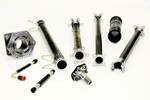TISICS landing gear sparks shift in aviation lightweighting
Ceramic fiber-reinforced metal composite technology has the potential to enables rapid decarbonization of aircraft fleets through landing gear, wing components, hydrogen storage, engines and future blended wing aircraft.

Metal-matrix composite Light Land gear. Photo Credit: TISICS
TISICS (Farnborough, U.K.), a company pioneering ceramic fiber-reinforced metal composite materials, is making strides in the commercial aviation sector by unveiling Light Land, the company’s lightweight landing gear for commercial aircraft. The innovation will reportedly deliver CO2 savings by 2030, as well as demonstrate improved fuel efficiency, helping to propel the aerospace industry toward its goal of achieving net zero emissions by 2050.
Currently, 50% of an aircraft is comprised of metal component. TISICS’ sustainable lightweight and high-strength hybrid alternative, developed as part of a project backed by £2.5 million in research and development (R&D) funding from UK Research and Innovation (UKRI) and Innovate UK, in collaboration with Safran Landing Systems (Vélizy-Villacoublay, France), is said to be the world’s largest fiber-reinforced metal composite component for commercial aircraft.
TISICS’ titanium and aluminum composites, reinforced with the company’s continuous silicon carbide (SiC) mono-filaments, are manufactured in the U.K., offering a weight reduction of 30-70% for high-performance systems, while leveraging their strength, mass, corrosion resistance, and temperature properties. Surpassing the strength and stiffness of titanium at a 40% lower density and outperforming high-strength steel, TISICS’ says its hybrid materials double the specific stiffness of common engineering metals.
The adoption of Light Land is projected to save airlines £650,000 in fuel costs per year, per aircraft, making them 13% more cost-effective compared to their titanium counterparts. Moreover, wide-body aircraft fleets using TISICS composites will contribute to a yearly CO2 emission reduction of 9.6 million tonnes.
TISICS believes its lightweight landing gear offers a compelling solution to reduce emissions and increase operational efficiency starting in 2028 and, eventually, expand across multiple aircraft systems, including ultra-efficient wings, engines and next-generation airframes.
“We’re excited to showcase the potential of Light Land for the U.K.’s aerospace industry,” Stephen Kyle-Henney, CEO of TISICS, says. “TISICS’ future products will lead to increased competitiveness for U.K. aero-manufacturers, securing a first-mover advantage in high-value markets. This will create a domestic supply chain, reshoring previously imported products and generating over 240 highly skilled jobs in the U.K. within the next 5 years.”
Related Content
-
Manufacturing the MFFD thermoplastic composite fuselage
Demonstrator’s upper, lower shells and assembly prove materials and new processes for lighter, cheaper and more sustainable high-rate future aircraft.
-
Plant tour: Spirit AeroSystems, Belfast, Northern Ireland, U.K.
Purpose-built facility employs resin transfer infusion (RTI) and assembly technology to manufacture today’s composite A220 wings, and prepares for future new programs and production ramp-ups.
-
Cryo-compressed hydrogen, the best solution for storage and refueling stations?
Cryomotive’s CRYOGAS solution claims the highest storage density, lowest refueling cost and widest operating range without H2 losses while using one-fifth the carbon fiber required in compressed gas tanks.
















